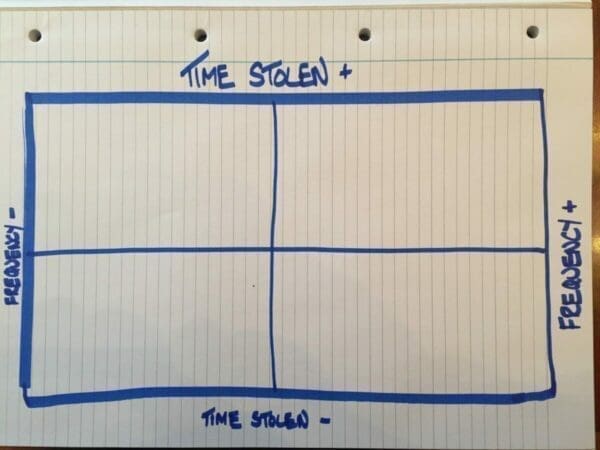Helping you, the HR Manager, to get more from your time…
Not another Time Management article?! No. Based on 15 years working with HR Managers as a Training Provider, an article that provides practical help. According to google 480 of you are looking for ‘HRTime’ and getting a result that is not useful because it just shows some code about a node – Whatever that is?! These 7 practical tips will help you, the HR Manager, to get more out of your busy day.
The above image shows the number of searches for ‘hrtime’ in google.co.uk each month.
According to the Open University of Australia, the average full-time HR Manager works 42.2 hours per week. We suspect that you are doing more, so we’re here to help with 7 practical actions:
1. Stop Being So Helpful
Yes, we know it’s a tough place to start. The reality is that some people need help. Others need to do it themselves. If you are too helpful, you’ll make a ‘rod for your own back’.
You’ll have probably heard of Pavlov’s Dogs and the experiment. In essence, it’s about conditioning. If you condition people that when they ask, you help, they’ll ask. Why wouldn’t they? Sometimes they need to discover the answer for themselves. The other two examples that prove this point is Toyota. The founder was famous for not telling his people the answer, but helping them to solve it themselves because he wanted 4,000 problem solvers, not just the management to be 200 problems solvers. Project Oxygen, by google, also supports this way forward.
Action 1: Be a little less helpful. And coach the people that come to you to help them find the answer for themselves. Start small by doing this with 1 person this week.
2. Know Your Time Bandits
Some people steal your time. They probably shouldn’t as much as they do. Imagine the Boston matrix below. It is based on two axis; The number of time people steal on the vertical axis and how often they steal your time on the horizontal axis. Thinking about your Time Bandits, place them into the boxes.
Now you’ve done that, who is in the top right box. Ideally, there will be a maximum of 3 people.
Action 2: Speak with each of these 3 people to change what happens now. Maybe a weekly 121 for 20 minutes, or encourage them to speak with one of your team, or provide some resources so that they can solve their queries themselves. If it doesn’t work try something else. The worst thing you can do is nothing.

3. Say ‘No’ More Often
This 1-minute video will help. Based on William Ury’s book, ‘The Power of a Positive No: How to say no and still get to yes’, he asks us to visualise a tree. There are 3 particular parts to this tree that will help us to make the journey to saying no…

Action 3: Write a sentence of about 30 words where you say no. For example, ‘If I were to do the ABC project I’d not do my best work because of the DEF project I have on at the moment. I could do it next Friday’.
Sticky Learning ® is 7 times more effective than 1-day training courses. Plus, you will get a Chain of Evidence proving your Return on Investment. Discover soft skills training that changes behaviours long term.

4. Find Stealth Mode
Think Catwoman. To do the ‘deep work’ that is needed, you need to focus, have no distractions and be the best version of yourself. Whether stealth mode for you is booking a meeting room for you, just for you, working from home, getting out of the office to a coffee shop, or shutting the office door with a note ‘Do not Disturb’, stealth mode is essential.

Action 4: Book into your diary ‘Stealth Mode’ for 90 minutes within the next 2 weeks. And get some deep work done.
5. Stop Filing Emails
According to IBM research:
- Globally we send 2.8 million emails per second.
- We defer replying to 37% of emails that need a reply.
- There are 3 types of filers; No filers, frequent Filers, and Spring Cleaning Filers.
- Their research observed over 85,000 refinding actions. Where people looked for an email.
- We spend 10% of our time filing emails (Almost half a day per week!).
Here’s the rub. The conclusion of the research was twofold; Those that create folders don’t find anything quicker than those that don’t file. And we use folders not to file but to clear our inbox.
Action 5: Stop filing emails now. The reason you do is not what you think. Use advanced search instead, in your email software to find emails because you’ll always remember who it is from, or roughly when or the subject. Most companies archive emails for 7 years, so they’ll never be lost.
6. Why Are You on the Payroll?
As a Time Management trainer for over 15 years, this is the hardest for Learners to get their heads around, yet will also make a significant positive difference in getting the rights things done. Brian Tracy, the US time management expert talks about ‘Key Results Areas’. In essence, he challenges us to have 3 SMART objectives for why we are on the payroll.
If we do not I contest that you can only ever be 60% effective as a time manager. This is because if you were a lumberjack chopping down trees and you sweated all day doing so, similarly to working hard with your head down all day, but then found out you were chopping down the wrong trees, you’d be less than effective.
Action 6: Read this article to understand more about KRA’s and write your 3 SMART KRA’s and get them agreed with your boss.
7. Delegate Better
As a rule of thumb, most people are poor at delegating. Either because they don’t know how to do it effectively or because they just want to tick the task off of their to-do list. There are lots of tips about delegating more effectively. The tip that will have the most effect is to share a date with the person you are delegating too. So often we don’t want to share a date with the person because we think it can be too pushy. In fact, they’d rather know because then they can aim to get it right.
Action 7: When delegating tell the person the date you want it back by.
Summary of the HRTime 7 Practical Actions
- Action 1: Be a little less helpful. And coach the people that come to you to help them find the answer for themselves. Start small by doing this with 1 person this week.
- Action 2: Speak with each of these 3 people to change what happens now. Maybe a weekly 1-to-1 for 20 minutes, or encourage them to speak with one of your team, or provide some resources so that they can solve their queries themselves. If it doesn’t work try something else. The worst thing you can do is nothing.
- Action 3: Write a sentence of about 30 words where you say no. For example, ‘If I were to do the ABC project I’d not do my best work because of the DEF project I have on at the moment. I could do it next Friday’.
- Action 4: Book into your diary ‘Stealth Mode’ for 90 minutes within the next 2 weeks. And get some deep work done.
- Action 5: Stop filing emails now. Use advanced search in your email software to find emails because you’ll always remember who it is from, or roughly when or the subject. Most companies archive emails for 7 years, so they’ll never be lost.
- Action 6: Read this article to understand more about KRA’s and write your 3 SMART KRA’s and get them agreed with your boss.
- Action 7: When delegating tell the person the date you want it back by.




